Faces of the Austin Brown Berets
-
Susana Almanza
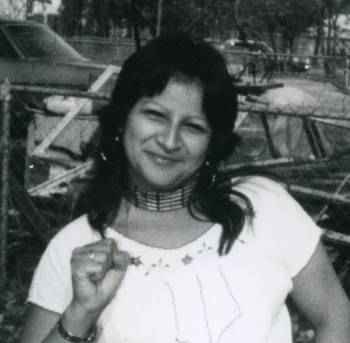 Growing up in a poor neighborhood in East Austin along with ten siblings, Susana Almanza's (formerly Renteria) first introduction to organizational discipline was through the Catholic Church. In 1973, Ernesto Fraga, a friend, and coworker invited twenty-one-year-old Almanza to a meeting at El Cristo Rey Church. Almanza understood the need and promotion of brotherhood and family amongst Chicanos and decided to join the Brown Berets after that first meeting. She became an essential member of the East Austin Chapter, along with other female members Almanza was able to provide a summer child care program which included free lunches and field trips for young Chicano children in the neighborhood. Almanza went on to co-write critical documents for the Texas Brown Berets including their state manifesto, eventually taking her experience into the creation of the Peoples Organized in Defense of Earth and her Resources (PODER) a grassroots East Austin environmental, economic, and social justice organization.
Growing up in a poor neighborhood in East Austin along with ten siblings, Susana Almanza's (formerly Renteria) first introduction to organizational discipline was through the Catholic Church. In 1973, Ernesto Fraga, a friend, and coworker invited twenty-one-year-old Almanza to a meeting at El Cristo Rey Church. Almanza understood the need and promotion of brotherhood and family amongst Chicanos and decided to join the Brown Berets after that first meeting. She became an essential member of the East Austin Chapter, along with other female members Almanza was able to provide a summer child care program which included free lunches and field trips for young Chicano children in the neighborhood. Almanza went on to co-write critical documents for the Texas Brown Berets including their state manifesto, eventually taking her experience into the creation of the Peoples Organized in Defense of Earth and her Resources (PODER) a grassroots East Austin environmental, economic, and social justice organization.Other Information
Locations
Fiesta Gardens and Festival Beach
2101 Jesse E. Segovia St, Austin, TX 78702El Cristo Rey Church
2215 E 2nd St, Austin, TX 78702Palm School
744 TX-343 Loop, Austin, TX 78701Holly Street Power Plant
2401 Holly Street, Austin, TX 78702 MapRanch in Leander
Leander, TxEl Centro Chicano
105 San Marcos St, Austin, TX 78702 (original location to 1979)&
1208 Willow St, Austin, TX 78702
(From 1979 to 1990s) -
Gavino Fernandez
Growing up in Austin's segregated housing Gavino Fernandez was always familiar with racism, especially during elementary school. Each summer the Fernandez family traveled to Michigan as migrant workers picking onions, tomatoes, and cherries. In the early 1970s, Gavino became a Brown Beret member while still in high school, serving with El Centro Chicano and also participating in demonstrations and protests. After graduating high school and attending Austin Community College Gavino took a job as a program specialist with the City of Austin within the Park and Recreations Department holding that position for over 17 years. Gavino was only a Brown Beret member for three or four years. He continued his activism while working for the city becoming a union stewardess organizing his coworkers to ask for permanent work positions and increased benefits. By the 1980s, Gavino transformed from young Brown Beret member to a community activist speaking against local politicians, some who were old acquaintances like Pio Renteria, on gentrification and reforms in the Austin school district.
Other Information
Locations
El Centro Chicano
105 San Marcos St, Austin, TX 78702 (original location to 1979)&
1208 Willow St, Austin, TX 78702
(From 1979 to 1990s)Pan American Center
2100 E 3rd St, Austin, TX 78702Holly Street Power Plant
2401 Holly Street, Austin, TX 78702 MapMichigan
-
Ernesto Fraga
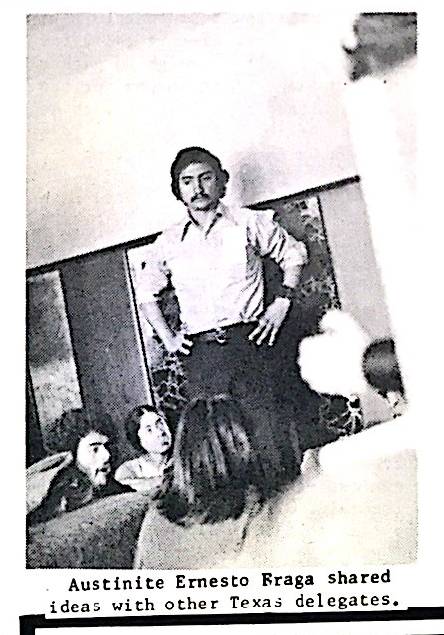
Born in Chicago, Illinois, Ernesto Fraga became politicized at a young age. Recommended for a War on Poverty program called the Neighborhood Youth Corp at seventeen-years-old then nominated as president of the Jr. LULAC organization for his high school. Later Fraga went on to organize the Mexican American Youth Organization (MAYO) in Waco and steered the conversation to include Mexican American history into a local public-school curriculum. Fraga made connections with Austin locals when he visited the city in support of the Economy Furniture workers strike in the late 1960s. In 1970 he moved to Austin for a position at the Human Opportunities Corporation and shortly after became the director of the South Austin Community Center. At twenty-years-old Fraga helped establish the East Austin Brown Beret chapter becoming a core member. In 1974 he assisted in the creation of the Brown Beret State manifesto and participated in a caravan headed to South Texas in an attempt to confront the Ku Klux Klan who wanted to patrol the Texas Mexico border. Fraga was essential to the relationship between the East Austin community newspaper the Echo and the Brown Berets. In the late 1980s, Fraga moved back to Waco where he currently resides, his participation in Chicano activism did not stop at the Brown Berets, in 2006 he helped organized marches against punitive immigration legislation and for immigration reform.
Other Information
Locations
Fiesta Gardens and Festival Beach
2101 Jesse E. Segovia St, Austin, TX 78702El Centro Chicano
105 San Marcos St, Austin, TX 78702 (original location to 1979)&
1208 Willow St, Austin, TX 78702
(From 1979 to 1990s)El Cristo Rey Church
2215 E 2nd St, Austin, TX 78702Economy Furniture Company
9315 McNeil Rd, Austin, TX 78758Old Austin City Hall
124 W 8th St, Austin, TX 78701 -
Paul Hernandez

Brown Beret co-founder and East Austin local Paul Hernandez experienced his coming-to-consciousness after he suffered a heart attack at age twenty-five. During his six-month long hospitalization, East Austin activist priest Father Joe Znotas gifted Paul Hernandez two texts to study. Paul proceeded to read Saul Alinsky’s Rules for Radicals along with books on liberation theology. By the mid-1970s Paul became a spokesperson and guard for Chicano East Austin residents, organizing demonstrations against police brutality through the Brown Berets. Paul acted as co-founder of the East Austin chapter and worked within the organization till its disbanding in the early 1980s. Most noted for his participation in anti-police protests, the Aqua Fest boat protests, and involvement within the Chicano community of East Austin through the creation of El Centro Chicano. In 1983, police attacked Paul after an anti-Klan rally following a city-sanctioned Ku Klux Klan. The assault resulted in broken ribs and eight stitches to the head. Paul went on to become the Director of the East Austin Chicano Economic Development Corporation and went on to run for District 51 Texas State Representative. Paul is now retired and continues to live in East Austin and stays connected with community issues.
Other Information
Locations
Rainey Street Neighborhood
79 Rainey Street
Rainey Street Historic District 787018th Street Austin Police Department
715 E 8th St, Austin, TX 78701El Centro Chicano
105 San Marcos St, Austin, TX 78702 (original location to 1979)&
1208 Willow St, Austin, TX 78702
(From 1979 to 1990s)Fiesta Gardens and Festival Beach
2101 Jesse E. Segovia St, Austin, TX 78702Old Austin City Hall
124 W 8th St, Austin, TX 78701Texas Capital
1100 Congress Avenue, Austin, TX 78701 -
Samuel Hernandez
 Born and raised in East Austin, Samuel Hernandez served eighteen months in Vietnam and shortly started a family upon his return. It was not till a few years after the establishment of the Brown Beret Austin chapter that Samuel became involved with the organization. Sam wanted to promote Chicano culture and educated children in his community about their heritage but also wanted to fight against police brutality and gentrification. During the Aqua Fest protests by the Brown Berets, police attacked peaceful protesters and arrested Paul and Sam for resisting arrest. The brothers staged a hunger strike while in jail gaining international media attention. The hunger strike worked to further apply pressure on City Council relocated the boat races away from residential housing. Following his departure from the Brown Berets in the 1980s, Samuel went on to work for Texas State University as an Instructional Technologies Support (ITS) specialist.
Born and raised in East Austin, Samuel Hernandez served eighteen months in Vietnam and shortly started a family upon his return. It was not till a few years after the establishment of the Brown Beret Austin chapter that Samuel became involved with the organization. Sam wanted to promote Chicano culture and educated children in his community about their heritage but also wanted to fight against police brutality and gentrification. During the Aqua Fest protests by the Brown Berets, police attacked peaceful protesters and arrested Paul and Sam for resisting arrest. The brothers staged a hunger strike while in jail gaining international media attention. The hunger strike worked to further apply pressure on City Council relocated the boat races away from residential housing. Following his departure from the Brown Berets in the 1980s, Samuel went on to work for Texas State University as an Instructional Technologies Support (ITS) specialist.Other Information
Locations
El Centro Chicano
105 San Marcos St, Austin, TX 78702 (original location to 1979)&
1208 Willow St, Austin, TX 78702
(From 1979 to 1990s)Fiesta Gardens and Festival Beach
2101 Jesse E. Segovia St, Austin, TX 78702Vietnam
-
Adela Mancias
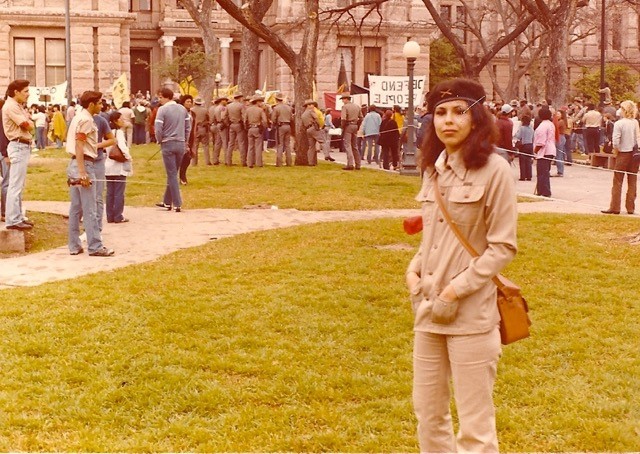
Adela Mancias worked as a contributor to the Raza Unida newspaper the Valiente leading her into East Austin and Brown Beret meetings. After witnessing a violent confrontation with police and protesters, Mancias became an active member of the East Austin chapter. She became involved with Beret efforts to educate the community, specifically about their rights as homeowners, the process of rezoning, and how to confront City Council as community members. Twenty-nine-year-old later Mancias gained media attention following a 1983 Klan march down Congress Avenue where state police officers attacked Paul Hernandez, Maria Limon, and Mancias. In the mid-1980s after leaving the Berets, Adela Mancias worked for a community public access show on ACTV promoting self-determination, community issues, women’s’ issues, education, civil rights, and Native American and Chicano history. Mancias now works as a reading specialist for low-income students.
Other Information
Locations
Rainey Street Neighborhood
79 Rainey Street
Rainey Street Historic District 787018th Street Austin Police Department
715 E 8th St, Austin, TX 78701El Centro Chicano
105 San Marcos St, Austin, TX 78702 (original location to 1979)&
1208 Willow St, Austin, TX 78702
(From 1979 to 1990s)Old Austin City Hall
124 W 8th St, Austin, TX 78701Texas Capital
1100 Congress Avenue, Austin, TX 78701 -
Sabino 'Pio' Renteria
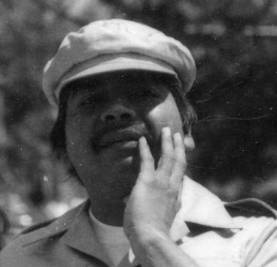
Pio Renteria attended the first Brown Beret organizing meeting with his sister Susana Renteria (Now Almanza) in 1972. He was quickly sold on the organization partially due to his prior organization experience through La Raza Unida. Renteria held personal experience with police brutality having been profiled then arrested at a young age. Frustrated with police behavior in his community Renteria became one of 15 core members of the East Austin Brown Berets. Pio was one of many Latino Austin citizens who benefited from IBM's commitment to expanding its presence in East Austin communities, working 34 years as a Computer & Printer Technician. Renteria continued his political activism after the Brown Berets serving on the East Austin Neighborhood Center Advisory Board, the AB Cantu/Pan Am Recreation Center Advisory Board, and the Environmental Board to name a few. In 2014, Renteria ran for city council and became a member of the Austin City Council representing his neighborhood of District 3.
Other Information
Locations
Fiesta Gardens and Festival Beach
2101 Jesse E. Segovia St, Austin, TX 78702El Cristo Rey Church
2215 E 2nd St, Austin, TX 78702Palm School
744 TX-343 Loop, Austin, TX 78701IBM
11501 Burnet Road, Austin, TexasEl Centro Chicano
105 San Marcos St, Austin, TX 78702 (original location to 1979)&
1208 Willow St, Austin, TX 78702
(From 1979 to 1990s) -
Gilbert Rivera
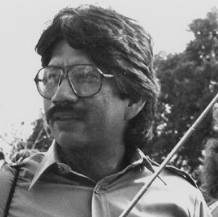 Gilbert Rivera experienced racial discrimination at a young age. At the age of six, he along with other primarily Spanish speaking students in the Austin school district suffered physical and mental abuse for not speaking English. Gilbert graduated from AISD at the age of 17, in 1972, he moved to Seattle, Washington to attend the University of Washington under a special program for migrant workers graduating with a master’s in social work. Encountering activism towards the end of high school where he met University of Texas students in the Mexican American Youth Organization who introduced him to Chicano literature. This literature fostered a sense of pride in a Chicano identity, that along with experiencing police brutality while attending a fundraiser where he explains he was “beat into militancy.” Following this event, he teamed up with others to create a Black Panther link organization in Austin, which became known as the Austin Brown Berets. Gilbert maintained membership until the organization dissolved in the early 1980s. He was involved with the founding of Resistencia bookstore working with Chicano poet Raul Salinas. Gilbert continues his activism with present-day anti-gentrification efforts and working with Save Our Youths, a writing program for teens in juvenile detention centers.
Gilbert Rivera experienced racial discrimination at a young age. At the age of six, he along with other primarily Spanish speaking students in the Austin school district suffered physical and mental abuse for not speaking English. Gilbert graduated from AISD at the age of 17, in 1972, he moved to Seattle, Washington to attend the University of Washington under a special program for migrant workers graduating with a master’s in social work. Encountering activism towards the end of high school where he met University of Texas students in the Mexican American Youth Organization who introduced him to Chicano literature. This literature fostered a sense of pride in a Chicano identity, that along with experiencing police brutality while attending a fundraiser where he explains he was “beat into militancy.” Following this event, he teamed up with others to create a Black Panther link organization in Austin, which became known as the Austin Brown Berets. Gilbert maintained membership until the organization dissolved in the early 1980s. He was involved with the founding of Resistencia bookstore working with Chicano poet Raul Salinas. Gilbert continues his activism with present-day anti-gentrification efforts and working with Save Our Youths, a writing program for teens in juvenile detention centers.Other Information
Locations
El Centro Chicano
105 San Marcos St, Austin, TX 78702 (original location to 1979)&
1208 Willow St, Austin, TX 78702
(From 1979 to 1990s)Fiesta Gardens and Festival Beach
2101 Jesse E. Segovia St, Austin, TX 78702Old Austin City Hall
124 W 8th St, Austin, TX 78701Resistencia Bookstore
105 San Marcos Street, Austin, TXCentro De la Raza / Resistencia Bookstore, Seattle, Washington
2524 16th Ave S, Seattle, WA 98144University of Washington
Seattle, WA 98195 -
Marcello Tafoya
Marcelo Tafoya was part of the broad stream of families that left Texas during World War II to work in heavy industry. The tafoyas, in this case, moved to Lorain, Ohio and Republic Steel. After the war, they returned to Georgetown, Texas, where he grew up in the tri-racially segregated schools of Central Texas.
He moved quickly into radio, partly he says, to avoid going to college. did well and managed to combine a career in political activism – working with PASSO, LULAC, and the Brown Berets; newspaper publishing – establishing the Eco out of the Pan American Recreation Center – and music, becoming one of the main producers and promoters of la Onda Tejana in Central Texas.
Other Information
Locations
Lorain, Ohio
Georgetown, TX
Pan American Recreation Center
City Hall
City Council
-
Raul Valdez
Growing up in the border town of Del Rio, Texas, a place with Mexican and Mexican American majority, Raul Valdez did not experience the same type of racism found in Central Texas. Aside from having segregated high schools most of the teaches, doctors, and lawyers he encountered were Chicanos. In the 1960s after graduation, Raul traveled to San Jose, California as a migrant worker picking apricots, strawberries, and pears. In the early 1970s, Raul traveled to Panama through the draft, but within six months he was ordered to Vietnam. Returning in 1971 to San Francisco, and eventually moved back to Texas and attended Texas A&I for a Bachelor of Fine Arts. Moving to Austin for graduate school at the University of Texas in Raul began to display his activism through music and art working with the Brown Berets. Many of Rauls art and songs focused on the Mexican Revolution and pre-colonial and indigenous imagery. His most notable mural was outside of the Chicano Juárez-Lincoln University and also painted panels displayed outside El Centro Chicano. Raul continues his art creating murals and paintings to display Chicano imagery and pre-colonial art.
Other Information
Locations
El Centro Chicano
105 San Marcos St, Austin, TX 78702 (original location to 1979)&
1208 Willow St, Austin, TX 78702
(From 1979 to 1990s)Juárez-Lincoln University
707 E. Cesar Chavez Street, Austin, TXUniversity of Texas at Austin
306 Inner Campus Drive, Austin, TX 78712San Jose, California
Vietnam
